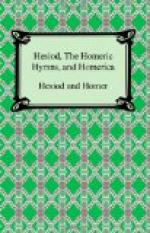(14) Hermes makes the cattle walk backwards way, so
that they
seem to be going towards the meadow instead of leaving it
(cp. l. 345); he himself walks in the normal manner, relying
on his sandals as a disguise.
(15) Such seems to be the meaning indicated by the context,
though the verb is taken by Allen and Sikes to mean, `to be
like oneself’, and so `to be original’.
(16) Kuhn points out that there is a lacuna here. In l. 109 the
borer is described, but the friction of this upon the
fireblock (to which the phrase `held firmly’ clearly
belongs) must also have been mentioned.
(17) The cows being on their sides on the ground, Hermes bends
their heads back towards their flanks and so can reach their
backbones.
(18) O. Muller thinks the `hides’ were a stalactite formation in
the `Cave of Nestor’ near Messenian Pylos, — though the
cave of Hermes is near the Alpheus (l. 139). Others suggest
that actual skins were shown as relics before some cave near
Triphylian Pylos.
(19) Gemoll explains that Hermes, having offered all the meat as
sacrifice to the Twelve Gods, remembers that he himself as
one of them must be content with the savour instead of the
substance of the sacrifice. Can it be that by eating he
would have forfeited the position he claimed as one of the
Twelve Gods?
(20) Lit. `thorn-plucker’.
(21) Hermes is ambitious (l. 175), but if he is cast into Hades
he will have to be content with the leadership of mere
babies like himself, since those in Hades retain the state
of growth — whether childhood or manhood — in which they
are at the moment of leaving the upper world.
(22) Literally, `you have made him sit on the floor’, i.e. `you
have stolen everything down to his last chair.’
(23) The Thriae, who practised divination by means of pebbles
(also called THRIAE). In this hymn they are represented as
aged maidens (ll. 553-4), but are closely associated with
bees (ll. 559-563) and possibly are here conceived as having
human heads and breasts with the bodies and wings of bees.
See the edition of Allen and Sikes, Appendix III.
(24) Cronos swallowed each of his children the moment that they
were born, but ultimately was forced to disgorge them.
Hestia, being the first to be swallowed, was the last to be
disgorged, and so was at once the first and latest born of
the children of Cronos. Cp. Hesiod “Theogony”, ll. 495-7.
(25) Mr. Evelyn-White prefers a different order for lines #87-90
than that preserved in the MSS. This translation is based
upon the following sequence: ll. 89,90,87,88. — DBK.
(26) `Cattle-earning’, because an accepted suitor paid for his
bride in cattle.
seem to be going towards the meadow instead of leaving it
(cp. l. 345); he himself walks in the normal manner, relying
on his sandals as a disguise.
(15) Such seems to be the meaning indicated by the context,
though the verb is taken by Allen and Sikes to mean, `to be
like oneself’, and so `to be original’.
(16) Kuhn points out that there is a lacuna here. In l. 109 the
borer is described, but the friction of this upon the
fireblock (to which the phrase `held firmly’ clearly
belongs) must also have been mentioned.
(17) The cows being on their sides on the ground, Hermes bends
their heads back towards their flanks and so can reach their
backbones.
(18) O. Muller thinks the `hides’ were a stalactite formation in
the `Cave of Nestor’ near Messenian Pylos, — though the
cave of Hermes is near the Alpheus (l. 139). Others suggest
that actual skins were shown as relics before some cave near
Triphylian Pylos.
(19) Gemoll explains that Hermes, having offered all the meat as
sacrifice to the Twelve Gods, remembers that he himself as
one of them must be content with the savour instead of the
substance of the sacrifice. Can it be that by eating he
would have forfeited the position he claimed as one of the
Twelve Gods?
(20) Lit. `thorn-plucker’.
(21) Hermes is ambitious (l. 175), but if he is cast into Hades
he will have to be content with the leadership of mere
babies like himself, since those in Hades retain the state
of growth — whether childhood or manhood — in which they
are at the moment of leaving the upper world.
(22) Literally, `you have made him sit on the floor’, i.e. `you
have stolen everything down to his last chair.’
(23) The Thriae, who practised divination by means of pebbles
(also called THRIAE). In this hymn they are represented as
aged maidens (ll. 553-4), but are closely associated with
bees (ll. 559-563) and possibly are here conceived as having
human heads and breasts with the bodies and wings of bees.
See the edition of Allen and Sikes, Appendix III.
(24) Cronos swallowed each of his children the moment that they
were born, but ultimately was forced to disgorge them.
Hestia, being the first to be swallowed, was the last to be
disgorged, and so was at once the first and latest born of
the children of Cronos. Cp. Hesiod “Theogony”, ll. 495-7.
(25) Mr. Evelyn-White prefers a different order for lines #87-90
than that preserved in the MSS. This translation is based
upon the following sequence: ll. 89,90,87,88. — DBK.
(26) `Cattle-earning’, because an accepted suitor paid for his
bride in cattle.




